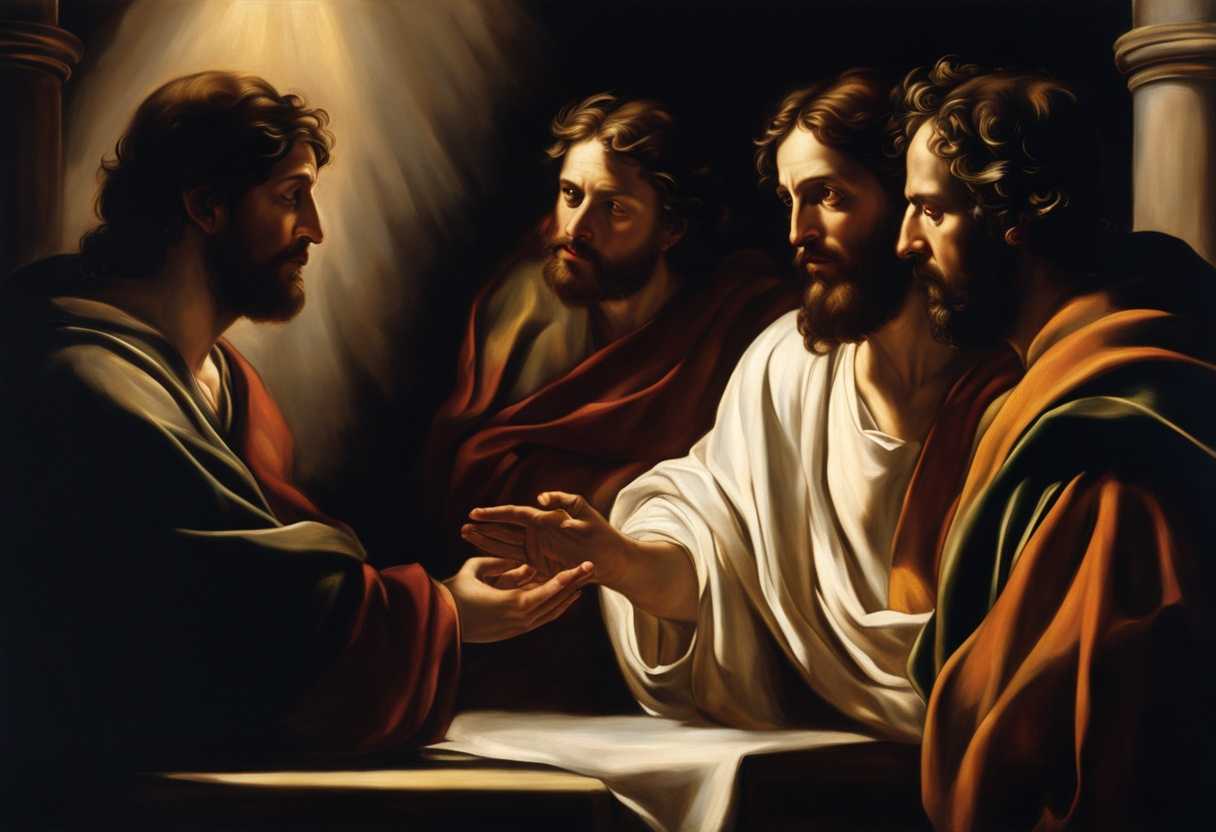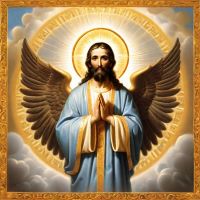In the Bible, Thomas is a disciple of Jesus, known for his initial skepticism about Jesus’ resurrection. The name “Thomas” means “twin” in Aramaic, and he is often referred to as “Doubting Thomas” due to his famous question regarding the necessity of seeing Jesus’ wounds to believe in His resurrection (John 20:24-29).

Scripture
16 So Thomas, called the Twin, said to his fellow disciples, “Let us also go, that we may die with him.”
Meaning of Thomas in the Bible
Thomas is indeed one of the most intriguing figures among the disciples, representing the genuine struggle of faith and belief. His skepticism, as recorded in John 20:24-29, encapsulates a profound truth about the human condition: the tension between doubt and faith. In his insistence on needing physical proof of the resurrected Christ, Thomas echoes a universal quest for understanding and reassurance amidst uncertainty. Jesus’ response not only addresses Thomas directly but also extends an invitation to all believers, highlighting that while physical evidence can lead to belief, true faith transcends sight: “Blessed are those who have not seen and yet have believed” (John 20:29). This statement reaffirms the significance of faith in the unseen, framing belief as a relationship of trust rather than mere acknowledgment of empirical evidence.
Moreover, the broader narrative of Thomas can be seen as a vital aspect of the Christian faith, which emphasizes the importance of grappling with doubt. His journey pushes beyond skepticism to a profound proclamation of faith when he addresses Jesus as “My Lord and my God!” (John 20:28), marking a pivotal moment in the gospel. This encounter underscores the transformative power of personal experience and revelation in the faith journey. Thomas’s story encourages believers to embrace their doubts and questions, as they can lead to deeper understanding and stronger faith, ultimately expressing the biblical assurance that God meets individuals where they are, guiding them from uncertainty toward a more profound acknowledgment of His presence and truth.
Beyond his moment of doubt, Thomas is often seen as a symbol of the broader human experience within the biblical narrative. His character is pivotal in illustrating that questions and struggles do not disqualify one from understanding or experiencing God. In the more extensive narrative of the disciples, Thomas uniquely challenges the conception of blind faith by bringing genuine inquiry into the forefront. This theme resonates throughout other parts of Scripture where believers are encouraged to seek understanding and not shy away from their uncertainties. Such a perspective invites believers to explore the complexities of their faith journeys, much like Thomas did.
Furthermore, the legacy of Thomas extends into early Christian tradition, where he is often associated with missionary work. According to various early church writings, Thomas traveled to India to spread the gospel, exemplifying the transformation from doubt to active faith. This journey signifies that faith can propel believers into action, encouraging others to explore their own beliefs. Thomas’ letter to the believers underscores that theological exploration and reassuring others in their uncertainties is essential in nurturing faith. Thus, the life of Thomas serves as a compelling reminder that faith is not a linear path, but a complex voyage that includes doubts, questions, revelations, and ultimately, the powerful call to share one’s belief with the world.
The Nature of Doubt and Faith
Thomas, often referred to as “Doubting Thomas,” embodies the struggle between skepticism and belief. His story illustrates that doubt is a natural part of the faith journey. This character serves as a reminder that questioning and seeking evidence can lead to a deeper understanding and stronger faith. The narrative encourages believers to confront their doubts and seek truth, ultimately leading to a more profound conviction.
The Role of Witness and Testimony
Thomas’s experience highlights the importance of personal testimony in the faith community. His eventual declaration of faith after encountering the risen Christ emphasizes that personal experiences can validate beliefs. This aspect of Thomas’s story encourages believers to share their own encounters with the divine, fostering a community built on shared experiences and mutual encouragement in faith.
The Universality of Human Experience
Thomas represents the universal human experience of doubt, fear, and the quest for understanding. His story resonates with many who grapple with their beliefs in the face of uncertainty. By portraying a disciple who struggles yet ultimately believes, the narrative invites all individuals, regardless of their faith journey, to recognize that doubt does not disqualify one from faith but can be a stepping stone toward a more profound relationship with God.
How to Strengthen Faith Through Doubt and Resurrection
As you navigate your journey of faith, it’s essential to recognize that doubt can be a powerful catalyst for growth rather than a stumbling block. Embrace your questions and uncertainties, for they can lead you to a deeper understanding of God’s love and grace. Just as the disciples experienced doubt after Christ’s crucifixion, they were transformed by the resurrection, which ignited their faith and propelled them into action. Allow your moments of doubt to drive you to seek answers through prayer, scripture, and community. Remember, faith is not the absence of doubt but the courage to trust in God’s promises despite it. As you reflect on the resurrection, let it remind you that new life and hope can emerge from your struggles, reinforcing your belief that God is always at work, even in the shadows of uncertainty.
Bible References to the Meaning of Thomas:
John 14:5-7: 5 Thomas said to him, “Lord, we do not know where you are going. How can we know the way?”
6 Jesus said to him, “I am the way, and the truth, and the life. No one comes to the Father except through me.
7 If you had known me, you would have known my Father also. From now on you do know him and have seen him.
John 20:24-29: 24 Now Thomas, one of the twelve, called the Twin, was not with them when Jesus came.
25 So the other disciples told him, “We have seen the Lord.” But he said to them, “Unless I see in his hands the mark of the nails, and place my finger into the mark of the nails, and place my hand into his side, I will never believe.”
26 Eight days later, his disciples were inside again, and Thomas was with them. Although the doors were locked, Jesus came and stood among them and said, “Peace be with you.”
27 Then he said to Thomas, “Put your finger here, and see my hands; and put out your hand, and place it in my side. Do not disbelieve, but believe.”
28 Thomas answered him, “My Lord and my God!”
29 Jesus said to him, “Have you believed because you have seen me? Blessed are those who have not seen and yet have believed.”
John 21:1-14: 1 After this Jesus revealed himself again to the disciples by the Sea of Tiberias, and he revealed himself in this way.
2 Simon Peter, Thomas (called the Twin), Nathanael of Cana in Galilee, the sons of Zebedee, and two others of his disciples were together.
3 Simon Peter said to them, “I am going fishing.” They said to him, “We will go with you.” So they went out and got into the boat, but that night they caught nothing.
4 Just as day was breaking, Jesus stood on the shore; yet the disciples did not know that it was Jesus.
5 Jesus said to them, “Children, do you have any fish?” They answered him, “No.”
6 He said to them, “Cast the net on the right side of the boat, and you will find some.” So they cast it, and now they were not able to haul it in, because of the quantity of fish.
7 That disciple whom Jesus loved therefore said to Peter, “It is the Lord!” When Simon Peter heard that it was the Lord, he put on his outer garment, for he was stripped for work, and threw himself into the sea.
8 The other disciples came in the boat, dragging the net full of fish, for they were not far from the land, but about a hundred yards off.
9 When they got out on land, they saw a charcoal fire in place, with fish laid out on it, and bread.
10 Jesus said to them, “Bring some of the fish that you have just caught.”
11 So Simon Peter went aboard and hauled the net ashore, full of large fish, 153 of them. And although there were so many, the net was not torn.
12 Jesus said to them, “Come and have breakfast.” Now none of the disciples dared ask him, “Who are you?” They knew it was the Lord.
13 Jesus came and took the bread and gave it to them, and so with the fish.
14 This was now the third time that Jesus was revealed to the disciples after he was raised from the dead.
Matthew 10:2-4: 2 The names of the twelve apostles are these: first, Simon, who is called Peter, and Andrew his brother; James the son of Zebedee, and John his brother;
3 Philip and Bartholomew; Thomas and Matthew the tax collector; James the son of Alphaeus, and Thaddaeus;
4 Simon the Zealot, and Judas Iscariot, who betrayed him.
Mark 3:16-19: 16 He appointed the twelve: Simon (to whom he gave the name Peter);
17 James the son of Zebedee and John the brother of James (to whom he gave the name Boanerges, that is, Sons of Thunder);
18 Andrew, and Philip, and Bartholomew, and Matthew, and Thomas, and James the son of Alphaeus, and Thaddaeus, and Simon the Cananaean,
19 and Judas Iscariot, who betrayed him.
Luke 6:13-16: 13 And when day came, he called his disciples and chose from them twelve, whom he named apostles:
14 Simon, whom he named Peter, and Andrew his brother, and James and John, and Philip, and Bartholomew,
15 Matthew, and Thomas, and James the son of Alphaeus, and Simon who was called the Zealot,
16 and Judas the son of James, and Judas Iscariot, who became a traitor.
Acts 1:12-14: 12 Then they returned to Jerusalem from the mount called Olivet, which is near Jerusalem, a Sabbath day’s journey away.
13 And when they had entered, they went up to the upper room, where they were staying, Peter and John and James and Andrew, Philip and Thomas, Bartholomew and Matthew, James the son of Alphaeus and Simon the Zealot and Judas the son of James.
14 All these with one accord were devoting themselves to prayer, together with the women and Mary the mother of Jesus, and his brothers.
Reverend Ogunlade is a seasoned Church Minister with over three decades of experience in guiding and nurturing congregations. With profound wisdom and a serene approach, Reverend Ogunlade has carried out various pastoral duties, including delivering uplifting sermons, conducting religious ceremonies, and offering sage counsel to individuals seeking spiritual guidance. Their commitment to fostering harmony and righteousness within their community is exemplified through their compassionate nature, making them a beloved and trusted figure among the congregation.
